A new exhibition season opens at the Capitoline Museums, specifically in the spaces of Villa Caffarelli, where the exhibition Greece in Rome will be open from November 28, 2025 until April 12, 2026. The event, which includes a preview reserved for the press on Thursday, Nov. 27, takes the form of a wide-ranging archaeological and art-historical investigation, curated by Eugenio La Rocca and Claudio Parisi Presicce. The initiative is promoted by Roma Capitale and the Sovrintendenza Capitolina ai Beni Culturali, making use of the organization of Zètema Progetto Cultura. The exhibition also constitutes the second part of the thematic cycle The Great Masters of Ancient Greece. This path of research was inaugurated with the monographic exhibition dedicated to Phidias, held between November 2023 and May 2024, and now continues with the intention of analyzing the rediscovery of the protagonists of Hellenic art and, above all, their lingering legacy in Roman and, by extension, Western culture.
The exhibition project brings together more than one hundred and fifty works, selected from sculptures, reliefs and archaeological finds of various kinds. The distinctive feature of the selection then lies in the nature of the objects: they are exclusively Greek originals, a precise curatorial choice aimed at showing the authentic material that came to Rome, distinguishing it from the albeit vast production of copies from the Roman age. Instead, some of the artifacts are being displayed to the public for the first time, offering scholars and visitors the opportunity to observe never-before-seen materials. The narrative unravels as a chronological and thematic journey that starts from the founding of Rome and crosses the centuries to the height of the imperial age. Indeed, the goal is to restore the complexity and force with which Greek art penetrated the Roman social fabric, a phenomenon of acculturation that occurred in stages: first through the channels of early trade and later through the great campaigns of conquest in the Eastern Mediterranean. It was in this second phase that the influx of works of art became massive, bringing priceless masterpieces to Rome including marble and bronze statues, finely chiseled silverware, paintings, and luxurious furnishings.


The impact of this artistic invasion entailed a radical transformation of the face of the city. Greek works found their place in squares, public buildings and gardens, contributing decisively to the redefinition of Roman aesthetic and cultural patterns. Among the many masterpieces that make up the tour are the great Capitoline bronzes, which have been exceptionally brought together for the occasion, allowing a direct comparison of pieces of incredible workmanship. Alongside these, the exhibition offers key monuments for understanding ancient sculpture, such as the stele from Grottaferrata Abbey. Of particular scientific importance is the operation conducted on the Niobidi sculptures from the Horti Sallustiani: the pieces, historically dispersed between the collections of Rome and those of Copenhagen, are reassembled in the context of the exhibition, allowing a unified reading of a sculptural group fragmented by the vicissitudes of historical collecting.
An additional element of interest is the return, charged with a strong symbolic value, of a female acroterial sculpture. The work was originally part of the Renaissance collection of Cardinal Alessandro Peretti Montalto, one of the most prestigious collections of the time. Sold more than two centuries ago and leaving the Roman borders, the sculpture is now finally visible again in the city context from which it came, offering food for thought on the dynamics of the antiques market and the dispersion of heritage in past centuries. However, the exhibition is not limited to the great statuary masterpieces already known to historiography, but also includes unpublished finds that shed new light on daily life and trade flows. These include Attic ceramics recently unearthed during archaeological excavations at the Colosseum; their display to the public for the first time constitutes an important update on the material data on the presence of Greek imports in the heart of ancient Rome.


The installation at Villa Caffarelli was also designed to complement the viewing of the works with an advanced multimedia apparatus. Various video projections accompany the visitor along the route, offering a path that helps contextualize the exhibits and visualize the original environments or historical reconstructions necessary to fully understand the dialogue between the two civilizations. Foreign institutions that have granted works include the Ny Carlsberg Glyptotek in Copenhagen, the Museum of Fine Arts in Boston, the Metropolitan Museum of Art in New York, the British Museum in London, and the Museum of Fine Arts in Budapest. The contribution of Italian institutions was also crucial, with loans from the Vatican Museums, the Museo Nazionale Romano, the Uffizi Galleries in Florence and the Museo Archeologico Nazionale in Naples. Works from important private collections, with particular reference to the Sorgente Group Foundation in Rome and the Al Thani Collection in Paris, complete the exhibition framework.
 |
| Greece in Rome: 150 works at the Capitoline Museums recount the millennial dialogue between two civilizations |
Warning: the translation into English of the original Italian article was created using automatic tools. We undertake to review all articles, but we do not guarantee the total absence of inaccuracies in the translation due to the program. You can find the original by clicking on the ITA button. If you find any mistake,please contact us.